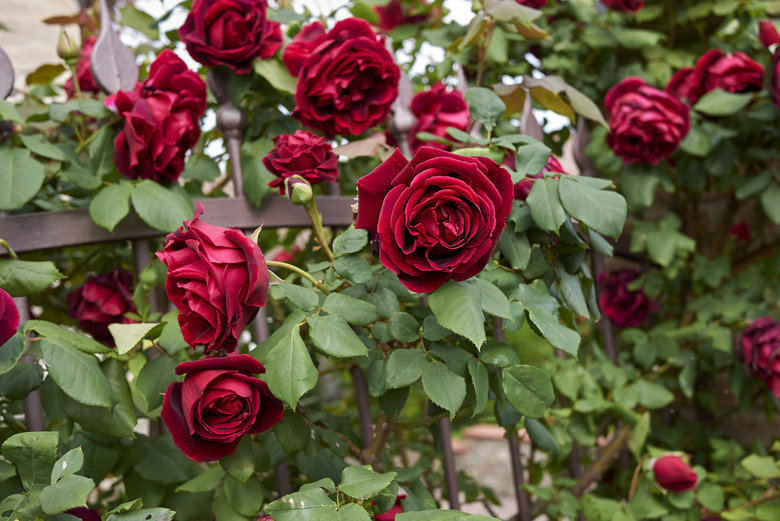How To Take Care Of Climbing Roses
Learning to take care of climbing roses (Rosa spp.) is a great way to add new dimension and height to your yard or flower garden. They're typically easier to care for and more vigorous than other roses. If you've grown roses before, understand that caring for climbing roses isn't exactly the same as caring for other types of roses. Although some of their requirements are similar, many things are different.
Things Needed
-
Water
-
Mulch
-
Trellis or similar structure
-
String or soft cloth
How to Take Care of Climbing Roses
1. Choose a Sunny Spot
Plant climbers in an area that receives plenty of sun. While some climbers will do well in partial shade, even up to half a day of shade, most need plenty of direct sun. In general, lighter-colored climbing roses will be more tolerant of shade the darker-colored roses.
2. Amend the Soil
Amend clay and sandy soils with compost, manure, mulch or peat moss, or plant the roses in an area that has rich, loamy soil with good drainage.
3. Mulch Around Climbing Roses
Cover soil with 2 to 4 inches of organic mulch such as straw, pine needles, buckwheat hulls, ground corn cobs, peat moss, wood chips, shredded bark, cottonseed hulls, chopped leaves, peat nuggets or grass clippings. This will keep the soil moist and the roots cool. Mulch in early spring while the rose bush is still dormant.
4. Water Climbing Roses
Water climbing roses, if necessary, so that they get at least 1 inch of water per week and 2 inches of water if planted on sandy soil. Water in the morning and avoid wetting the leaves to prevent fungal problems.
5. Fertilize the Plants
Fertilize in the spring after pruning. Use a dry, commercial rose fertilizer that has a slow release form of nitrogen. Apply about 1/2 cup to the soil, or according to label directions if they vary from this recommendation. During the summer, apply a foliar spray of diluted liquid fertilizer (50 percent strength) according to label directions, up until six weeks before the first frost is expected.
6. Install a Support Structure
Support climbing roses by tying the canes to a trellis, frame or similar structure. Tie them loosely with string, soft cloth or plastic. Climbing roses don't have tendrils or suckers like vines, so they require external supports to grow vigorous. If possible, allow your roses to grow horizontally, then vertically, as they will produce more flowers.
7. Prune Climbing Roses
Prune climbing roses once they're at least 3 to 4 years old. In the spring, remove any dead wood, weak canes and any canes to avoid overcrowding or crossing. You'll only need to prune every other year, although hardy climbers can be pruned every year. Your goal in pruning is to keep the roses in the area you want and ensure that only strong canes remain, not to limit its growth. Use only sharp, clean pruning shears and make slanting cuts about 1/4 inch above a growth bud.
8. Deadhead Spent Flowers
Deadhead roses by removing any spent flowers. Cut back the stem to a 5-leaf leaflet.
9. Provide Winter Protection
Protect climbing roses in the winter if you live in an area where temperatures frequently get and stay below freezing. For the best results, remove the canes from their support and cover them with soil. If you can't remove them from their supports, make sure they're securely tied and cover them with a burlap screen or similar material. Also, cover the base of the plant with soil or mulch.
